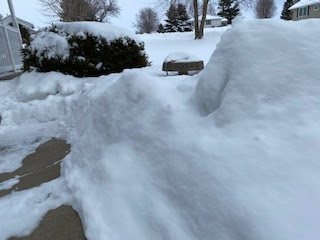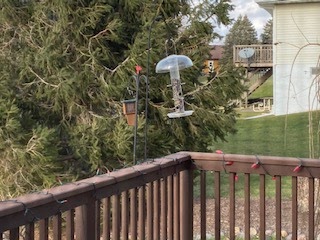This season and the brutal winter of 1978-79
 |
| Snow pack in the front of the Baker home, February 2021, in rural Scott County. |
There's a pack of snow on the edge of the driveway that I'm hoping to tackle ... maybe after the snow that's expected tonight. It is irritating, to this driver anyway, and in the way of anyone who wishes to approach our house in a vehicle.
As I do this, I'll be thinking of the shoveling done so far. Couple that with climate experts who predict this winter will mirror that of 1978-79.
Oh my!
Do you remember that winter? You must be of a certain age to think of it, but that season is unforgettable to many. I was a student at Iowa State University in Ames, majoring in journalism and history. I later had a career as a newspaper journalist so have heard many stories from other reporters.
One way the season started was January 12-14 when a winter storm dumped 18.4 inches of snow, according to archives of the National Weather Service in the Quad-Cities. It was a record for a single snowstorm.
But more marks were also broken: A record 26.7 inches of snow fell in January, and the snow depth was a record 28 inches of snow on the ground, Jan. 14-19.
 |
| The home of Emery Cox Jr., Jan. 13, 1979 |
The average daily temperature that winter was 14 degrees Fahrenheit. In January 1979, however, it was 6.3 degrees, a record. On Jan. 2, the record low temperature of negative 27 degrees was reached.
As a 20-year-old native of Minnesota, I was pretty impervious to the snow and cold. The travel along Interstate 80 was challenging to get back to Ames. My friend, Krista Weih, was also returning to Ames. She lived in rural Cedar County about 100 yards from a paved road. Krista remembers after that storm, the snow was so high on the gravel road that her father started the tractor, hooked it up to her car, and towed her to the highway through the ditch.
My father, Emery Cox, lived in Tipton, Iowa, and I had been home for Christmas in December 1978. He subsequently took two photos that appear with this blog, Jan. 12-13, 1979.
 |
| Dad's Chevy El Camino was covered in snow: Jan. 13, 1979. |
I learned more in later years. For example, how did reporters fare at my newspaper, the Quad-City Times in Davenport, Iowa? Staff members from that time shared their experiences with me. In addition, the Times published a series of stories in January, 2019, the 40th anniversary of that brutal winter.
Deb Brasier, regional editor, and now retired, terms it the "Winter of Discontent." That Saturday, she said the staff had produced one of the best-ever Sunday editions of the Times, but workers could not get the paper off the loading dock because the snow was so deep in the alley. The editor had reserved a block of rooms in the nearby Clayton House. Deb was one of those who waded through thigh-high snowdrifts to reach the hotel.
Weary staff, unwashed and desperate to get home, went back to work and fielded calls from subscribers who hadn't received the paper. They explained it was on the loading dock and the folks were asked, politely, to come and get it. At the end of Sunday night, staff got rides home but Deb's ride got stuck. Moline police officers dug them out. "It was the longest 48 hours of my life," she said.
Alma Gaul, reporter and editor of the popular Home & Garden Sunday section, sent her memories from the special newsroom project at the Quad-City Times. Alma was stranded for two days in Muscatine, Iowa, after attending a party of Times staffers.
In addition, the record cold in January did a number on her car, she wrote in the Times special section. To get her car started, she had to grind the starter before the engine would turn over. This wore down the battery. So, she started to take the battery out of the car at night, walk it into her house and set it on the marble top of a very hot radiator in the living room. She also hooked the battery to a charger. "And that worked," she wrote.
Lucinda Resnick, a reporter in those days, had quite a dramatic experience. She also provided a story in the Times special section and said January 1979 was when she started to hate snow. When the snowstorm hit on Jan. 13, she was picked up at home by a Times maintenance staffer who could navigate the roads in a Jeep. She stayed unexpectedly at the Times for three days, sleeping at the Clayton House hotel. When the storm was over she ended up in the hospital for more than a week.
Resnick's job at the Times was to write reports about accidents, and also do stories from all of the mayors, police and sheriff's officials outside the immediate metropolitan area. After three days, she returned home to wake up in severe pain. After several mis-diagnoses it turned out she had kidney stones, but that was after one painful week!
The brutal weather was not only in Iowa. A monster storm crashed Jan. 26, 1978, in northwest Ohio, with hurricane-force winds (some up to 80 miles-per-hour.) After it ended, there were 50 people killed and it caused $100 million in property damage. It is often called the "Storm of the Century." It was also one of the two worst winters ever recorded in Chicago.
Which brings us to 2021: So far, our nation is still dealing with the COVID-19 pandemic which is causing citizens to stay home, much of the time. That might be most sensible as we in the Midwest are caught in a polar vortex.
News reports on Feb. 15 say temperatures might get to more than 30 degrees Fahrenheit on Feb. 21 -- 17 days after the last time a temperature higher than 30 degrees was recorded.
It could be worse.



Comments
Post a Comment